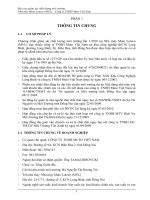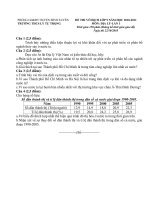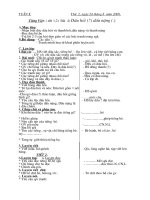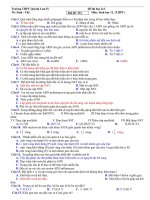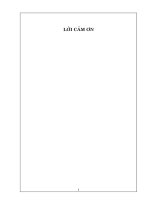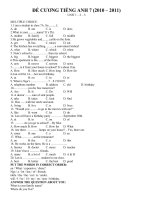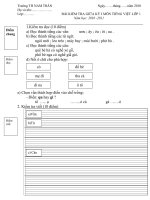Mathematical Reflections 1 (2010) problems
Bạn đang xem bản rút gọn của tài liệu. Xem và tải ngay bản đầy đủ của tài liệu tại đây (93.78 KB, 5 trang )
Junior problems
J145. Find all nine-digit numbers aaaabbbbb that can be written as a sum of fifth
powers of two positive integers.
Proposed by Titu Andreescu, University of Texas at Dallas, USA
J146. Let A
1
A
2
A
3
A
4
A
5
be a c onvex pentagon and let X ∈ A
1
A
2
, Y ∈ A
2
A
3
, Z ∈
A
3
A
4
, U ∈ A
4
A
5
, V ∈ A
5
A
1
be points such that A
1
Z, A
2
U, A
3
V , A
4
X, A
5
Y
intersect at P . Prove that
A
1
X
A
2
X
·
A
2
Y
A
3
Y
·
A
3
Z
A
4
Z
·
A
4
U
A
5
U
·
A
5
V
A
1
V
= 1.
Proposed by Ivan Borsenco, Massachusetts Institute of Technology, USA
J147. Let a
0
= a
1
= 1 and
a
n+1
= 1 +
a
2
1
a
0
+ · · · +
a
2
n
a
n−1
for n ≥ 1. Find a
n
in closed form.
Proposed by Titu Andreescu, University of Texas at Dallas, USA
J148. Find all n such that for each α
1
, . . . , α
n
∈ (0, π) with α
1
+ · · · + α
n
= π the
following equality holds
n
i=1
tan α
i
=
n
i=1
cot α
i
n
i=1
cot α
i
.
Proposed by Ivan Borsenco, Massachusetts Institute of Technology, USA
J149. Let ABCD be a quadrilateral with ∠A ≥ 60
◦
. Prove that
AC
2
< 2(BC
2
+ CD
2
).
Proposed by Titu Andreescu, University of Texas at Dallas, USA
J150. Let n be an integer greater than 2. Find all real numbers x such that {x} ≤
{nx}, where {a} denotes the fractional part of a.
Proposed by Dorin Andrica,“Babes-Bolyai” University, Romania and Mihai
Piticari, “Dragos-Voda” National College, Romania
Mathematical Reflections 1 (2010) 1
Senior problems
S145. Let k be a nonzero real number. Find all functions f : R −→ R such that
f(xy) + f(yz) + f(zx) − k [f(x)f(yz) + f (y)f (zx) + f(z)f(xy)] ≥
3
4k
,
for all x, y, z ∈ R.
Proposed by Marin Bancos, North University of Baia Mare, Romania
S146. Let m
a
, m
b
, m
c
be the medians, k
a
, k
b
, k
c
the symmedians, r the inradius, and
R the circumradius of a triangle ABC. Prove that
3R
2r
≥
m
a
k
a
+
m
b
k
b
+
m
c
k
c
≥ 3.
Proposed by Pangiote Ligouras, Bari, Italy
S147. Let x
1
, . . . , x
n
, a, b > 0. Prove that the following inequality holds
x
3
1
(ax
1
+ bx
2
)(ax
2
+ bx
1
)
+ · · · +
x
3
n
(ax
n
+ bx
1
)(ax
1
+ bx
n
)
≥
x
1
+ · · · + x
n
(a + b)
2
.
Proposed by Marin Bancos, North University of Baia Mare, Romania
S148. Let n be a positive integer and let a, b, c be real numbers such that a
2
b ≥ c
2
.
Find all real numb e rs x
1
, . . . , x
n
, y
1
, . . . , y
n
for which
x
1
y
1
+ · · · + x
n
y
n
=
a
2
and
x
2
1
+ · · · + x
2
n
+ b(y
2
1
+ · · · + y
2
n
) = c.
Proposed by Dorin Andrica, “Babes-Bolyai” University, Romania
S149. Prove that in any acute triangle ABC,
1
2
1 +
r
R
2
− 1 ≤ cos A cos B cos C ≤
r
2R
1 −
r
R
.
Proposed by Titu Andreescu, University of Texas at Dallas, USA
S150. Let A
1
A
2
A
3
A
4
be a quadrilateral inscribed in a circle C(O, R) and circum-
scribed about a circle ω(I, r). Denote by R
i
the radius of the circle tangent to
A
i
A
i+1
and tangent to the extensions of the sides A
i−1
A
i
and A
i+1
A
i+2
. Prove
that the sum R
1
+ R
2
+ R
3
+ R
4
does not depend on the position of points
A
1
, A
2
, A
3
, A
4
.
Proposed by Ivan Borsenco, Massachusetts Institute of Technology, USA
Mathematical Reflections 1 (2010) 2
Undergraduate problems
U145. Consider the determinant
D
n
=
1 2 · · · n
1 2
2
· · · n
2
.
.
.
.
.
.
.
.
.
.
.
.
1 2
n
· · · n
n
.
Find lim
n→∞
(D
n
)
1
n
2
ln n
.
Proposed by Ivan Borsenco, Massachusetts Institute of Technology, USA
U146. Let n be a positive integer. For all i, j = 1, , n define S
n
(i, j) =
n
k=1
k
i+j
.
Evaluate the determinant ∆ = |S
n
(i, j)|.
Proposed by Dorin Andrica,“Babes-Bolyai” University, Romania
U147. Let f : R → R be a differentiable function and let c ∈ R such that
b
a
f (x) dx = (b − a) f (c) ,
for all a, b ∈ R. Prove that
f
(c) = 0.
Proposed by Bogdan Enescu, “B. P. Hasdeu” National College, Romania
U148. Let f : [0, 1] ⇒ R be a continuous non-decreasing function. Prove that
1
2
1
0
f(x)dx ≤
1
0
xf(x)dx ≤
1
1
2
f(x)dx.
Proposed by Duong Viet Thong, Hanoi University of Science, Vietnam
Mathematical Reflections 1 (2010) 3
U149. Find all real numbers a for which there are functions f, g : [0, 1] → R such that
for all
(f(x) − f(y))(g(x) − g(y)) ≥ |x − y|
a
for all x, y ∈ [0, 1].
Proposed by Gabriel Dospinescu, Ecole Normale Superieure, France
U150. Let (a
n
) and (b
n
) be sequences of positive transcendental numbers such that
for all positive integers p the series
n
(a
p
n
+ b
p
n
) converges. Suppose that for all
positive integers p there is a positive integer q such that
n
a
p
n
=
n
b
q
n
. Prove
that there is an integer r and a permutation σ of the set of positive integers
such that
a
n
= b
r
σ(n)
.
Proposed by Gabriel Dospinescu, Ecole Normale Superieure, France
Mathematical Reflections 1 (2010) 4
Olympiad problems
O145. Find all positive integers n for which
1
4
+
1
4
2
4
+
1
4
· · ·
n
4
+
1
4
is the square of a rational number.
Proposed by Titu Andreescu, University of Texas at Dallas, USA
O146. Find all pairs (m, n) of positive integers such that ϕ(ϕ(n
m
)) = n, where ϕ is
Euler’s totient function.
Proposed by Marco Antonio Avila Ponce de Leon, Mexico
O147. Let H be the orthocenter of an acute triangle ABC, and let A
, B
, C
be the
midpoints of sides BC, CA, AB. Denote by A
1
and A
2
the intersections of circle
C(A
, A
H) with side BC. In the same way we define points B
1
, B
2
and C
1
, C
2
,
respectively. Prove that points A
1
, A
2
, B
1
, B
2
, C
1
, C
2
are concyclic.
Proposed by Catalin Barbu, Bacau, Romania
O148. Let ABC be a triangle and let A
1
, A
2
be the intersections of the trisectors of
angle A with the circumcircle of ABC. Define analogously points B
1
, B
2
, C
1
, C
2
.
Let A
3
be the intersection of lines B
1
B
2
and C
1
C
2
. Define analogously B
3
and
C
3
. Prove that the incenters and circumcenters of triangles ABC and A
3
B
3
C
3
are collinear.
Proposed by Daniel Campos Salas, Costa Rica
O149. A circle is divided into n equal sectors. We color the sectors in n − 1 colors
using each of the colors at least once. How many such colorings are there?
Proposed by Ivan Borsenco, Massachusetts Institute of Technology, USA
O150. Let n be a positive integer, ε
0
, , ε
n−1
the n
th
roots of unity, and a, b complex
numbers. Evaluate the product
n−1
k=0
(a + bε
2
k
).
Proposed by Dorin Andrica,“Babes-Bolyai” University, Romania
Mathematical Reflections 1 (2010) 5
